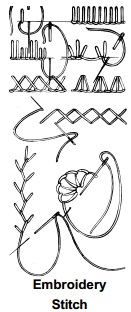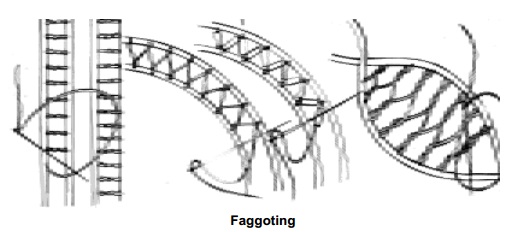Chapter: 11th 12th std standard Textiles And Dress Designing Cloth stitch Higher secondary school College practical steps methods Notes
Decorating Garments

DECORATING GARMENTS
INTRODUCTION:
Trimmings and details like frills, embroidery, applique, belts, bows, smocking, tuck-ing, lace, ricrac etc., gives the interesting effects on simple dress designs.
DECORATING GARMENTS:
1. Bias trimmings:
Bias binding in contrasting material or self fabric can be used to finish neck lines, opening and hems in garments. Bias tubing can be used for making decorative button loops.
2. Ric rac:
This is available in different colors at very low cost and is very durable. (It should be tested for color fastness before attaching to garment). Ric rac can be sewn flat on the garment through the centre or it may be attached around edges or between seams so that just one edge is show on the right side of the garment. A motif made of ric rac adds further decoration.

3. Ruffles:
This is also a type of frill. To make a pattern for circular ruffle. Cut a piece of circular fabric with its inner circle equal to the circumference of the neckline and its outer circle 1'-
2' away from the inner circle. Cut the circular fabric at any one point and attach it the inner circle to the neckline of the garment. Double ruffle can be attached to the armhole hemline on either sides. The placement of the double ruffle gives a panelled effect to the front of the garment.
4. Embroidery:
Simple embroidery designs enhance the appearance of children's garments. In the dress design chain stitch for couching stitch can been worked to small motifs with lazy daisy stitches or bullion stitches are worked within the false yoke and godet. Instead of embroidery, beads or sequins can be applied.

5. Smocking:
This is done by gathering and embroidering over the gathers. This can be worked only over a plain cloth. When this is done with practice this looks attractive. After knotting the thread work running stitches from right to left of equal width. Gather the fabric and wind it over the pin head. Then work desired stitch over the gathered fabric. This is used to decorate waistline, sleeve, neckline, Yoke and any other part of the garment. This stitch looks attractive and liked by many of them.
6. Faggoting:
This trim is used between seams to give a decorative touch or to add the length or width of garment. To executive the design cut the yoke and the lower section of the blouse separately, with �' seam allowances. Also cut the yoke pattern on heavy paper with one inch allowance. Fold under the allowance on edge of the yoke where faggoting is to be done and tack the folded edge to the prepared pattern. Now tack also the lower section of the blouse after folding in the seam allowance Then do the faggoting with zigzag stitches between foldings.

7. Applique:
Applique is a cutout piece of fabric that is stitched to a larger background for decoration. An applique can be purchased or made by cutting out a design from one or more fabrics. Fabrics that ravels easily should not be used. Applique is a very effective trim for children's garments. It can be applied on pockets, yokes, above the hemline etc. The applique work on the right front corner just above the hemline looks attractive.
8. Lace:
Lace can be used as edging, insertion and banding. Lace for edging has one straight edge which is to be applied to the fabric. It is commonly used at the neckline, armhole, sleeve hem, garment hem, yoke line etc. Lace may be gathered to give a frilled effect.
Lace for insertion has its two edges finished symmetrically. A design with fine tucks and insertion of lace can be combined and applied in a horizontal direction. The bias tubing inserted in such lace can be tied into a bow. The tubing may also be pulled to produce gathers. An attractive band can be made by placing lace over contrasting or self colored ribbon or fabric slightly narrower than the lace. The ribbon is then attached to the garment in the desired portion.
9. Lace motifs:
Lace motifs are very effective when sewn over contrasting fabric. The motifs can be cut out from a wide lace or bought as such. Cut the outline of the motif in a contrasting colored lining fabric and tack it to the wrong side of the lace motif. Trim the lining fabric slightly smaller around the edge. Now, applique the lined motif on the garment in the desired place.
10. Belts and bow:
These have functional and decorative uses. In children's garments. fabric belts are most commonly used. Belts may be made out of contrasting material or the garment material it self. The belt may be tied with a bow at the back or at one side. Bows may be attached near the neckline, shoulder, hemline, along the centre front line etc.
11. Decorative fasteners:
Decorative fastenings include fabric buttons and loops eylets and cord, fancy buttons, fabric buttonholes etc. On a plain dress with contrasting collar or piping, buttons covered with the collar piping material would be effective. Buttons may be fixed in groups to create design interest gradually progressing in size from small to big.
12. Pockets:
Pockets of different shapes, sizes and location with or without decorative details suited to the design of the garment can enhance the appearance of the garment.
13. Scalloped edging:
Scalloped shapes at garment edges (neckline, hemline openings etc.) are ordinarily made by cutting in the desired shape and finishing with bias binding or shaped facing. A similar effect may be produced however by the use of embroidery stitches. The effect of a scalloped front opening is obtained by drawing the scallops in uniform shape and working blanket stitch with contrasting colored thread along the lines Scallop drawn. This can be used in frocks, skirt, kids wear, neckline, sleeve and in table cloth.
Related Topics